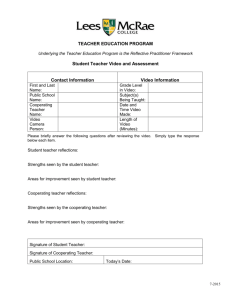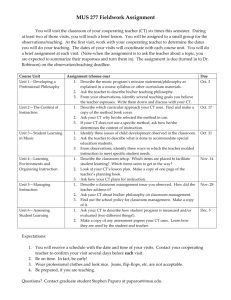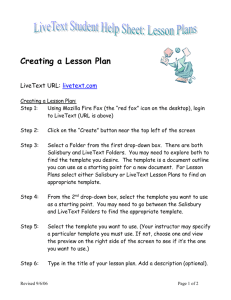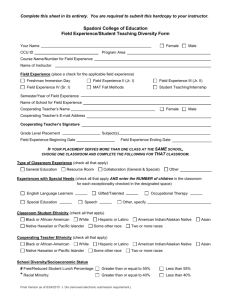Initial Visit and Student Teacher
advertisement
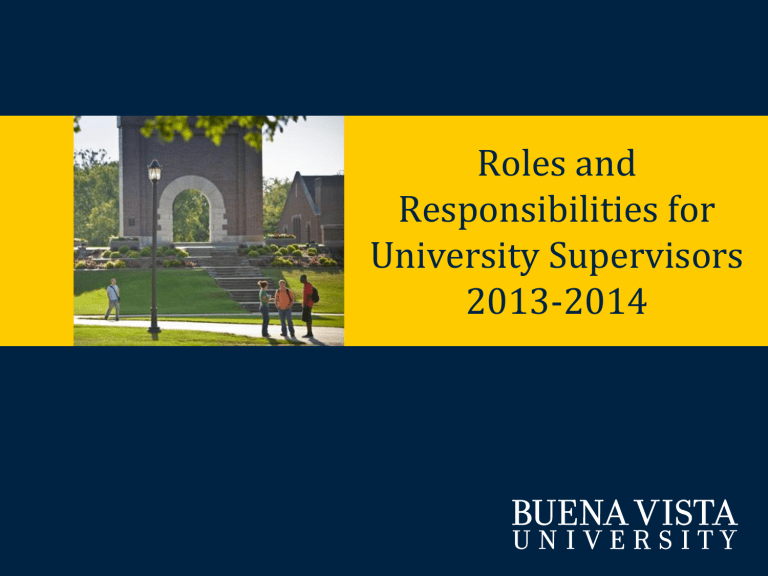
Roles and Responsibilities for University Supervisors 2013-2014 Purpose of PowerPoint Thank you for helping our teacher candidates in their last and very important field experience as a student teacher. Without you, our students could not complete their training. This PowerPoint will introduce you to or help clarify the roles and responsibilities of a University Supervisor. The slides will also serve as a resource for your work. Information for University Supervisors • Handbook – Responsibilities are outlined in each student teaching handbook. – Handbooks can be found on http://www.bvu.edu/bv/teachered/policieshandbooks.dot • Webpage – http://www.bvu.edu/bv/teachered/resources/ (Choose University Supervisors) • Education Coordinator – Contact the Education Coordinator or Student Professional Experiences Coordinator with specific questions you have Meeting Your Student Teacher Once you have been assigned to a student teacher, please – – – – – Make contact with him/her Introduce yourself Exchange contact information Review your role with the student teacher Emphasize that open and frequent communication is necessary for this experience to be successful and as rich as possible Meeting Your Student Teacher • Student teacher/cooperating teacher/university supervisor meetings – Some sites and campus hold these meetings to introduce one another and to review student teaching requirements with a BVU staff member – This meeting is not to be considered the initial visit for the student teaching placement. Visiting Your Student Teacher • The state of Iowa requires the following, “Involvement of the college or university supervisor in the formative evaluation of practitioner candidates through a minimum of biweekly observations and consultations.” • Therefore the number of visits you will complete will depend on the length of the student teaching placement. Visiting Your Student Teacher Placement Length Visits 4 weeks Initial visit/consultation + 1 or 2 Formal Observations 8 weeks Initial visit/consultation + 3 Formal Observations 14 weeks Initial visit/consultation + 6 Formal Observations 16 weeks Initial visit/consultation + 7 Formal Observations • Visits should be conducted the first week and then every other week thereafter until the total number of initial visit and formal observations are completed • Additional visits may be required to support a student teacher. Making additional visits should be discussed with the Student Professional Experiences Coordinator or Education Coordinator/Advisor prior to doing so. Arranging Visits • Arrange a time for classroom visits so that you can observe the student teacher from the beginning of a lesson through the end. • Arrange visits so there is time to discuss progress, give suggestions, receive input, etc in conversations with the: – student teacher in a 2-way conference in private – cooperating teacher in a 2-way conference in private – cooperating teacher and student teacher in a 3-way conference Prior to the Classroom Visit • Before entering any classroom, please go to the office to identify yourself and let the school know you are there for a student teacher visitation. • Please meet and thank the principal for allowing the BVU student teacher to have this experience in the building Initial Visit • Conduct this visit during the first week of school • Meet with the student teacher and cooperating teacher to: – – – – – review the student teaching handbook explain policies and procedures describe what will happen when you come to visit answer any questions thank the cooperating teacher for hosting the student teacher Initial Visit and Student Teacher • During the Initial Visit, please review with your student teacher your expectations regarding: – Submission of Weekly Reflections – Submission Lesson Plans prior to your formal observations – The importance of communicating during the experience – Other information as necessary and desirable • Initial Visit and Cooperating Teacher During the Initial Visit, please review with the cooperating teacher: – The importance of communicating during the experience – Forms that must be completed • Student Teaching Experience Checklist (the student will submit this on LiveText) • 2-Week Evaluation submitted on paper to you • Mid-Term Evaluation completed on LiveText • Final Evaluation completed on LiveText • Final Grade sheet submitted on paper to you ***Note: descriptors for evaluations are found in the student teacher handbook Initial Visit and Cooperating Teacher • Remind the cooperating teacher that LiveText login information has been or will soon be emailed to the teacher’s school email account. • If the teacher has questions about LiveText, an instruction packet and contact information with the BVU LiveText manager is found at: http://www.bvu.edu/bv/teachered/livetext/c ooperating-teachers.dot •F Initial Visit Form • Complete the Initial Visit/Consultation Form found in the student teacher handbook or online http://www.bvu.edu/bv/teachered/resources/un iversity-supervisors.dot • Write on the form what you discussed with the cooperating teacher/student teacher • Have the student teacher and cooperating teacher sign and date the form • You will also need to sign and date it Formal Observations • These visits will need to be scheduled between the student teacher and you. During this visit you will need to complete a Lesson Observation Form and a University Supervisor’s Observation Form. • The number of formal observations will depend on the length of the student teaching placement. (Please refer to chart on slide #7) • Copies of these forms can be found in the student teaching handbook http://www.bvu.edu/bv/teachered/resources/univer sity-supervisors.dot Formal Observation and the Cooperating Teacher • Upon arrival for each of the visits, please take a moment to meet with the cooperating teacher to ask if he/she has any questions/concerns, areas of improvement the students needs to focus on, etc. Please feel free to take notes and report back to the University. • Any time a concern arises, please contact the Student Professional Experiences Coordinator or Education Coordinator/Advisor immediately. Formal Observation and the Student Teacher • At the conclusion of each observation, sit down with the student teacher one-on-one to go over the results of the lesson. • Carefully review how the lesson plan compared to the actual lesson, questions/concerns you had with the lesson, and always encourage reflective questioning. • Remember, your job is to be a positive motivator and yet be able to provide constructive feedback to the student teacher. • Always give suggestions on how to improve and be sure to highlight items the student teacher did well. • Include the cooperating teacher in a 3-way conference during or after your conference with the student teacher. Extra Visits and Communication • If you believe that a student teacher needs more support from you than visits every other week, please contact the Student Professional Experiences Coordinator or Education Coordinator/Advisor to schedule more visits. • If, at any time, there are questions or concerns that have been raised either by you or the cooperating teacher, contact the Student Professional Experiences Coordinator or Education Coordinator/Advisor immediately. Growth Plan • A Growth Plan is a tool to help students be successful if the cooperating teacher or the university supervisor believes there is a need for a specific plan for improvement. • The growth plan can be completed after the identification of a need for improvement with input from the Cooperating Teacher, Student Teacher, and the Student Professional Experiences Coordinator or Education Coordinator/Advisor. • Contact Student Professional Experiences Coordinator or Education Coordinator/Advisor if you believe a student teacher needs a Growth Plan. Weekly Reflections The student teachers complete a written reflection each week throughout the student teaching experience. These reports consist of a reflection based on various guiding standards such as the BVU Teacher Education Program Pillars, InTASC standards, and the Iowa Teaching Standards. Each reflection has a set of guiding questions based on that week’s theme. Weekly Reflections • The student teachers are to upload Weekly Reflections into LiveText no later than Saturday evening at midnight. • The first weekly reflection is due the Saturday after the first week of student teaching. • There are no rubrics for Weekly Reflections. You may respond to the student teacher’s Weekly Reflections in the manner you choose. LiveText Help • If you have questions about LiveText, an instruction packet can be found at: http://www.bvu.edu/bv/teachered/livetext/S upervisors.dot • The LiveText tech support is also a source of help: support@livetext.com Additional LiveText Help For LiveText assistance, please contact Leah Schimmer (located in Storm Lake) By phone 712.749.2156 By email at schimmerl@bvu.edu Her office hours are M-F 9am-3pm. Cooperating Teachers and Student Teachers are also welcome to contact Leah with LiveText questions and issues. Exceptions to LiveText • Students who seek only an Endorsement and not an initial teaching license or certification do not use LiveText. • Arrange with the student teacher how you will receive Weekly Reflections. • The cooperating teacher will not be using LiveText for mid-term and final evaluations. The teacher will give the paper forms to you. Cooperating Teachers and LiveText Please monitor LiveText uploads by cooperating teachers and student teachers. If there is an absence of uploads, either assist the cooperating teacher/student teacher or contact the Student Professional Experiences Coordinator or Education Coordinator/Advisor. Questions regarding LiveText may be answered by referring to material on the Teacher Education Materials webpage, through LiveText Support or by contacting Leah Schimmer. Resources and contact information can be found at http://www.bvu.edu/bv/teachered/livetext/ Final Evaluation • Final Formal Observation: This visit will be scheduled between the student teacher, the cooperating teacher, and you. During this visit you will need to complete the Lesson Observation Form and the University Supervisor’s Observation Form. • At this meeting, you and the cooperating teacher can complete the final evaluation and final evaluation grade sheet. The Final Evaluation is completed within LiveText. The Final Grade Sheet is a hard copy form that is turned into the BVU office. Grading the Student Teacher • You are responsible for assigning student teacher grades. • While the cooperating teacher is asked to recommend a grade, the final decision rests with the Buena Vista University supervisor. • BVU will support the grade you give the student teacher. You must be able to support your grade decision. Grading • To determine a grade for the student teacher, solicit input from the cooperating teacher and base the evaluation on the student teacher’s demonstrated abilities at the end of the student teaching assignment. • You may also consider the – quality of lesson plans – content of Weekly Reflections when considering a final grade – input from administrators and others who have knowledge of the student teacher Checklists • Checklists are provided in the student teacher handbook and online at: http://www.bvu.edu/bv/teachered/resources /university-supervisors.dot • The Checklists are meant to be a tool for you to track your responsibilities and visits with your student teacher. Forms submitted to Student Professional Experiences Coordinator or Education Coordinator/Advisor • For accreditation purposes, hard copies of these forms completed by you are required: – University Supervisor Reports • Initial Visit • Formal Observations to include: – Lesson Observation Reports – Lesson plans from the formal observations – Final Grade Sheet • With comments and grade recommended by cooperating teacher – Final Evaluation (hard copy if not in LiveText) Forms submitted to Student Professional Experiences Coordinator or Education Coordinator/Advisor • Additionally, for accreditation purposes, you must submit these forms completed by the Cooperating Teacher: – 2 Week Progress Report (hard copy) – Mid-Term and Final Evaluation hard copies only if the student is excused from using LiveText • Please collect these evaluations from the cooperating teacher if paper copies are being used 60 Hour Rule Iowa Code regulating teacher education programs requires University Supervisors to acquire 60 hours of P-12 classroom experience. 79.12(6) Faculty members preparing practitioner candidates maintain an ongoing, meaningful involvement in activities in preschools, elementary, middle, or secondary schools. A minimum of 60 hours of activities of such activities shall include team teaching during the period between approval visits. A maximum of 30 hours of the 60 hour requirement may be completed by supervising preservice candidates in P-12 classroom settings.(from Iowa Code, 2007) 60 Hour Rule • The number of hours required is pro-rated for supervisors who begin working for BVU after the approval period has started. • For information and the Verification form, please contact the Student Professional Experiences Coordinator or Education Coordinator/Advisor; or go to http://www.bvu.edu/bv/teachered/resources /university-supervisors.dot Thank You Thank you for your work with BVU’s student teachers. Your experience and expertise are valued and appreciated as very important and beneficial to our teacher candidates.
